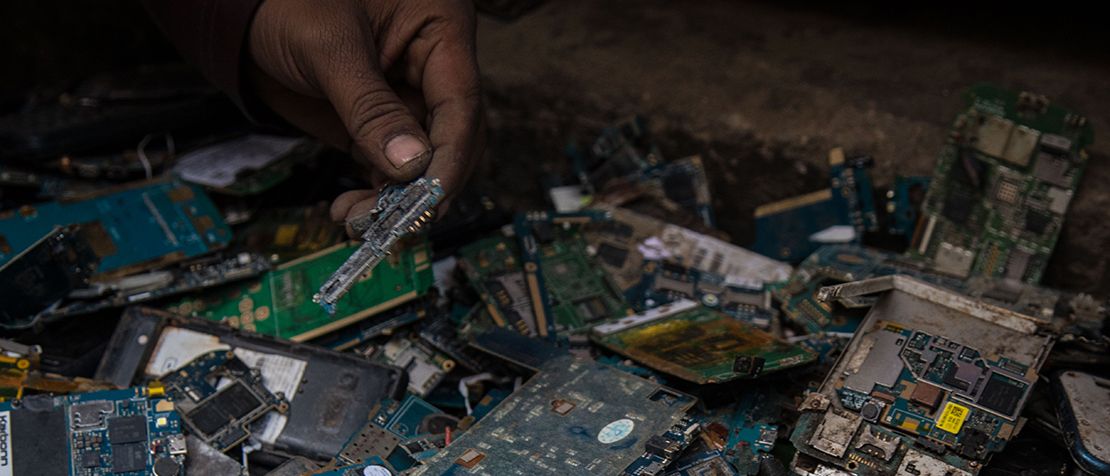
Digital solutions for a circular electronics value chain
Rapid digital uptake all over the world – in our workplaces, institutions, and daily lives – comes as a double-edged sword for humanity’s future. While countries worldwide invest in new tech and infrastructure to keep up with innovative applications and fast-growing demand for digitalization, the subsequent piles of discarded electronic equipment – or e-waste – keep growing, too.
Annual e-waste generation could reach 74.7 million tonnes by 2030.
Moving towards a circular economy is critical for environmental, health and societal reasons. But it also makes sense in economic terms.
“Current, linear economic models are not sustainable and suffer from instability due to their high dependence on limited natural resources,” says Vanessa Gray, Head of the Environment and Emergency Telecommunications Division at the International Telecommunication Union (ITU). “This makes a solid case for circular electronic value chains.”
Digital solutions for business, government, and other purposes, therefore, can present a dilemma from a waste-management perspective. They require careful management to keep electronics consumption under control, with proper end-of-life disposal for all system components. Yet their economic and social value – during their viable lifetime – remains undeniable.
Digital platforms can even accelerate moves towards circularity in the electronics value chain.
Examples range from simple online marketplaces, such as Recykal’s B2B e-waste marketplace, to Recupel’s sophisticated e-waste identification system powered by artificial intelligence (AI).
Opportunities for digital upgrades span the whole waste-management value chain – from design and raw material sourcing to all aspects of product distribution and use, to eventually closing the loop by reintroducing secondary materials recovered from e-waste.
Zooming in on digital solutions
E-waste policy and regulation are attracting interest and gaining momentum around the world, with more and more countries recognizing stakeholder consultation and producer responsibility as key principles. Connectivity, transparency, and accountability must all be heightened to ensure effective, fair, and economically viable e-waste management.
Producer responsibility organizations (PROs) can help to manage and monitor downstream e-waste flows.
They collect information that can be reported back to regulatory authorities and their membership, always maintaining visibility over the chain of custody of e-waste.
“The sheer amount of e-waste that needs to be managed demands a speed, accuracy and accessibility that only a digital system can provide. Such a system also opens a gateway to promote transparency, traceability and accountability across the value chain,” says Pranshu Singhal, founder of Karo Sambhav – or “Make Possible” – an Indian PRO that helps enterprises close their material loops.
Multiple layers of logistics, administration and approval processes go into an efficient and effective e-waste management system. But the latest hardware and software can bring every aspect together on a single, portable device.
Technologies and methods such as cloud computing, scanning/identification, automated validation, and document verification technologies help e-waste managers collect data and record activities across the value chain, improve the chain-of-custody visibility, and control of in-built management systems.
How to engage consumers
To mark International E-Waste Day on 14 October, the International Telecommunication Union (ITU) has prepared a thought paper in partnership with the WEEE Forum, mobile telecom industry group GSMA, and an international sustainability project management and consulting firm, Sofies Group.
The paper – Digital Solutions for a Circular Value Chain — looks at the applicability and scope of digital technologies to integrate circularity across the electronics value chain.
International E-Waste Day 2021 highlights the importance of consumer participation.
By choosing the channels where their e-waste is diverted, consumers can play an active role in improving the system.
Digital technologies can help lower barriers, incentivize consumer participation, and build public awareness and buy-in, the thought paper notes.
To take one example, e-waste collection applications such as the Egyptian app E-tadweer can target consumers by providing digital coupons in exchange for old electronics.
Read the thought paper and register for the 26 October webinar, where the contributing organizations will discuss digitalization in the e-waste sector.
Learn more about International E-Waste Day 2021.
